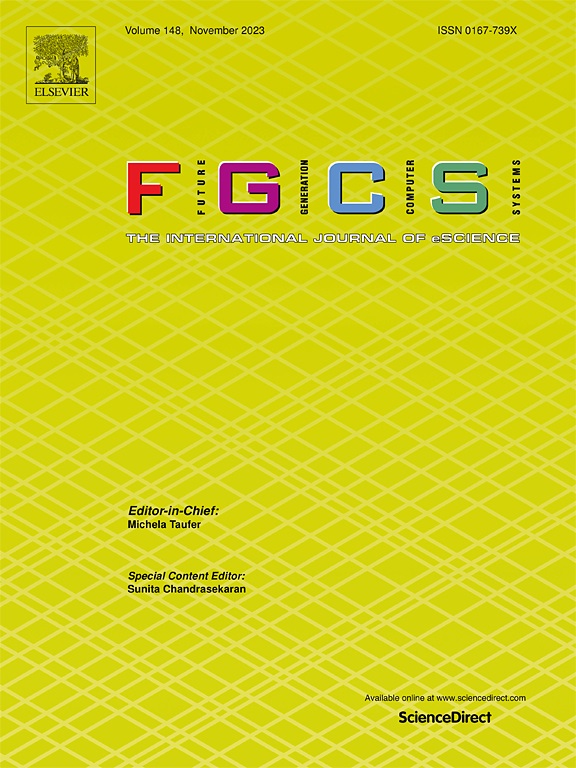针对 Web 3.0 中的元宇宙环境使用量子传送的区块链辅助隐私保护签名方案
IF 6.2
2区 计算机科学
Q1 COMPUTER SCIENCE, THEORY & METHODS
Future Generation Computer Systems-The International Journal of Escience
Pub Date : 2024-11-04
DOI:10.1016/j.future.2024.107581
引用次数: 0
摘要
在下一代互联网技术的前沿,"元宇宙"(metaverse)的概念正受到越来越多的关注。它将虚拟世界和物理世界统一为一个单一的虚拟领域,并有可能彻底改变社交网络、游戏、医疗保健和教育。量子远程传输技术以其确保通信安全和可靠的能力而闻名,它将改变这个身临其境的数字领域中的交互方式。然而,随着量子计算的发展,通常依赖数学复杂性的传统密码系统将不再可靠和安全。将现有的后量子加密技术应用到区块链架构中,会提高算法的时间复杂性,从而导致效率相对较低和大量的资源开销。相比之下,量子加密技术能够提高区块链的安全性和效率。此外,当前的元宇宙平台对中心化机构的依赖凸显了去中心化以提高互操作性和安全性的必要性。Web 3.0 技术通过实现去中心化的元宇宙生态系统提供了一种解决方案。因此,所提出的方法利用量子远距传输实现安全通信,量子密码学与 Web 3.0 的整合提高了元宇宙环境的效率、安全性和现实性。通过严格的安全性和效率分析,我们证明了该协议的稳健性和性能,确保其符合不可伪造性、不可否认性、可验证性和可追溯性等基本安全属性。本文章由计算机程序翻译,如有差异,请以英文原文为准。
A blockchain-assisted privacy-preserving signature scheme using quantum teleportation for metaverse environment in Web 3.0
At the forefront of next-generation internet technology, the concept of the metaverse is gaining traction. It unifies the virtual and physical worlds into a single virtual realm and has the potential to revolutionize social networks, gaming, healthcare and education. Quantum teleportation, renowned for its ability to ensure secure and reliable communications, is set to transform interactions within this immersive digital realm. Nevertheless, the conventional cryptosystems that typically rely on mathematical complexity will no longer be dependable and secure with the advancement of quantum computing. Applied to blockchain architecture, existing post-quantum cryptography technologies, which raise the time complexity of the algorithm, will result in relatively low efficiency and substantial resource overhead. In contrast, quantum cryptography has the ability to improve blockchain’s security and efficiency. Moreover, the reliance on centralized authorities in current metaverse platforms highlights the need for decentralization to improve interoperability and security. Web 3.0 technologies offer a solution by enabling a decentralized metaverse ecosystem. Therefore, the proposed approach leverages quantum teleportation to achieve secure communication and the integration of quantum cryptography and Web 3.0 enhances the efficiency, security and realism of metaverse environments. Through rigorous safety and efficiency analysis, we demonstrate the protocol’s robustness and performance, ensuring adherence to fundamental security properties such as unforgeability, undeniability, verifiability, and traceability.
求助全文
通过发布文献求助,成功后即可免费获取论文全文。
去求助
来源期刊
CiteScore
19.90
自引率
2.70%
发文量
376
审稿时长
10.6 months
期刊介绍:
Computing infrastructures and systems are constantly evolving, resulting in increasingly complex and collaborative scientific applications. To cope with these advancements, there is a growing need for collaborative tools that can effectively map, control, and execute these applications.
Furthermore, with the explosion of Big Data, there is a requirement for innovative methods and infrastructures to collect, analyze, and derive meaningful insights from the vast amount of data generated. This necessitates the integration of computational and storage capabilities, databases, sensors, and human collaboration.
Future Generation Computer Systems aims to pioneer advancements in distributed systems, collaborative environments, high-performance computing, and Big Data analytics. It strives to stay at the forefront of developments in grids, clouds, and the Internet of Things (IoT) to effectively address the challenges posed by these wide-area, fully distributed sensing and computing systems.

 求助内容:
求助内容: 应助结果提醒方式:
应助结果提醒方式:


